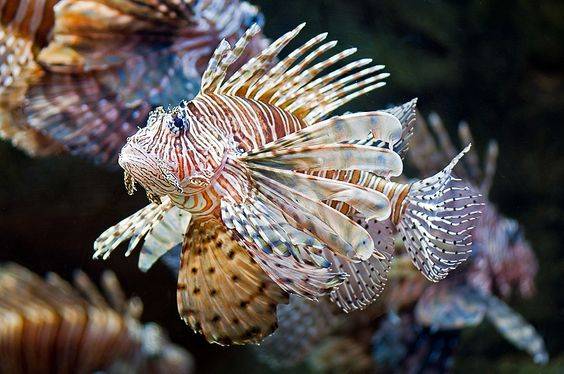Puerto Rico is home to many bizarre wonders. One of such wonders are lionfish. They are considered as invaders from a distant ocean as they were not as heavily populated before, as they are now.
There are two fish species commonly referred to as Lionfish: the Red Lionfish (Pterois volitans) and the Devil Firefish (Pterois miles). The Red Lionfish is native to the tropical and subtropical regions of the Indian and Pacific Oceans, while the Devil Firefish is native to the waters of the Red Sea. These two species are almost identical in appearance.
You can see them at reefs or some beaches where you snorkel.
The characteristics and biology of lionfish
Lionfish have distinctive brown or maroon, and white stripes or bands covering the head and body. They have fleshy tentacles above their eyes and below the mouth; fan-like pectoral fins; long, separated dorsal spines; 13 dorsal spines; 10-11 dorsal soft rays; 3 anal spines; and 6-7 anal soft rays.
This fish use their fan-like pectoral fins to “corner” their prey. Additionally, the spines of this species can deliver a venomous sting. Did you know that female lionfish can lay approximately 2 million eggs per year? They are also nocturnal animals.
Lionfish were given their unique name because they have long elegant pectoral fins that are fan-like and extend well beyond the tail, as well as a spiky first dorsal fin. These fins give the fish the appearance of a lion’s mane.
Lionfish are stalking predators that often corral prey into a corner. They can consume prey that are more than half of their own length and are known to prey on more than 70 marine fish and invertebrate species including yellowtail snapper, Nassau grouper, parrotfish, banded coral shrimp, and cleaner species.
Lionfish may be fun to look at but are actually harmful. They have vicious venom that they use to deter most predators from eating or harming them. This venom can cause great harm to humans, and especially young children. Lionfish are actually known to be one of the deadliest fish in the world. Additionally, some lionfish use the tentacle on their head to lure they prey in before attacking them for consumption.
Lionfish live exclusively in shallower waters with a depth of less than 500 feet. They tend to stay around rugged terrain, like coral reefs or lagoons, that helps them ambush and corner their prey. So, if you want an easy way to identify them, that should help. Furthermore, they are quite flamboyant and hard to miss, so the likelihood of you mistaking them for another type of fish is quite low.
The impact of lionfish on the marine ecosystem of Puerto Rico
As mentioned before, the flooding in of the recent numbers of lionfish in Puerto Rico is a pretty new thing.
Lionfish is infamous for its invasive presence in the waters of the Atlantic Ocean, the Caribbean Sea, and Gulf of Mexico, and Puerto Rico is no exception.
Invasive lionfish threaten native fish and the environment in Puerto Rico. They do this by causing the extinction of native plants and animals, reducing biodiversity, competing with native organisms for limited resources, and altering habitats.
To curb this problem, local fishermen and divers up and down the Atlantic coast and throughout the Caribbean are being encouraged to report any case of lionfish sightings. Moreover, some are being trained in the methods for safely collecting individual fish when they find them.
In addition to this, there are studies being conducted on the effect of introducing natural Lionfish predators into the Atlantic and Caribbean waters, such as large groupers and sharks.
Furthermore, lionfish are actually safe for humans to eat. As such, there is encouragement to introduce them into our diets. As a result, there are fishermen and trained professionals who hunt lionfish and supply them so that they can be eaten. There are even some thrilling competitions where culinary enthusiasts and chefs are made to come up with innovate ideas on how to cook these troublesome aquatic creatures.
Ways to encounter and appreciate lionfish in Puerto Rico
If you actually aim to encounter these beautiful yet deadly fish, you can do so by going diving or snorkelling in many of Puerto Rico’s beautiful waters. These fish have invaded pretty much everywhere, as mentioned above.
You can talk to local fishermen or hunters to learn more about them, their place in the Puerto Rican atmosphere, and perhaps get a greater understanding or appreciation for them (if you can overlook their deadliness, that is). You can equally visit any restaurant or food place that serves dishes made with lionfish and give them a good bite back while you enjoy the tasty flavours they may be accompanied by in your meal.
In the event that you get stung by a lionfish, here are some helpful things to do. It is good to remember that lionfish are not actively seeking you out, and so if you happen to swim near one, it is best to avoid any form of physical contact. Lionfish are generally harmless unless they are accidentally, or deliberately, threatened or disturbed.
If someone is stung by a Lionfish, the first thing to do is to call for help from a medical professional such as a lifeguard, or a paramedic immediately. The next thing to do is check the person’s airway, breathing and circulation, that will be some of the first bits of information the medical professionals will need. Lionfish venom tends to break down with the application of heat, so immersing the injured area in hot water or applying hot compresses should help relieve some of the pain. Once the pain is under control, check the wound for any pieces of the Lionfish spine that might have broken off. Then clean the wound, apply a sterile dressing and monitor the site for infection.
There are some tourism companies or groups that provide services that allow you to get closer to the lionfish for a fun and educative experience. Some of these are Lionfish Class and Hunt which is located at Aguadilla and allows you to scuba dive with goggles, masks, etc. Another on is the Puerto Rico Technical Diving Centre at El Natural.
Other marine animals in Puerto Rico to discover
There are many other interesting marine animals that you can find on the shores of Puerto Rico. Some of which are molluscs (snails, chiton, octopus), crustaceans (crabs, barnacle), echinoderms (sea urchin, cucumbers), cnidarians (anemones, coral), algae and segmented worms. Also, among the coral reefs on the western side of the island, you can see colourful specimens such as stoplight parrotfish, butterfly fish, seahorses ,and queen angelfish.
All in all, discovering the beauty of Puerto Rico by encountering the world of lionfish is a fun and educative adventure that you should try.


